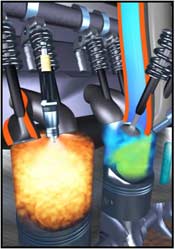Ricardo and a consortium of automotive partners have announced the completion of an advanced prototype research program based on the 2/4SIGHT engine concept. This petrol engine concept uses novel combustion, boosting, control and valve actuation technologies to enable automatic and seamless switching between two- and four-stroke operation, with the aim of delivering significant performance and fuel economy improvements through aggressive downsizing.
The 2/4SIGHT engine concept uses a direct injection gasoline combustion system in which the design of intake and exhaust ports, combined with appropriate changes in boost supply, fuel injection, ignition and valve timing, enable operation both in two-stroke and four-stroke modes. An advanced control system coupled with flexible valve actuation manages driver demands and coordinates operation of the boost system, valves and fuel injection equipment at an individual cylinder level. This enables smooth transitions between two- and four-stroke operation without torque interruption in both transient and constant torque conditions.
The research prototype engine is based on a single bank of a 2.1 litre V6, which in 6 cylinder 2/4SIGHT configuration is intended to deliver levels of performance and driveability more usually associated with a 3-4 litre V8 petrol engine. In order to enable the project team to assess control strategies in a completely unrestricted manner, an electro-hydraulic valve (EHV) actuation system was used for the prototype development rig.
The air handling system of the 2/4SIGHT concept is based on two-stage boosting and intercooling using a Rotrex supercharger and Honeywell turbocharger. For simplicity in the initial test bed prototype configuration, however, boosting is provided by an external compressed air supply. The engine control system of the prototype is a DENSO rapid prototyping system working with DENSO petrol direct injection and ignition components.
The prototype engine was built at the Ricardo Shoreham Technical Centre and installed for testing at the Sir Harry Ricardo Laboratories of the University of Brighton.
Highlights of development test results include:
- Smooth and reliable switching between two- and four-stroke modes under both constant torque conditions and transient operation.
- Control strategies amenable to implementation in cost-effective mechanical valvetrain hardware.
- Extremely high two-stroke specific torque demonstrated of 150 Nm/L at 1000 rev/min and 230 Nm/L at 2500 rev/min, opening the prospect of highly aggressive engine downsizing using the 2/4SIGHT engine concept.
Following completion of the test programme, Ricardo has carried out a vehicle drive cycle and acceleration performance simulation based on the steady state fuel consumption and full load performance of the 2/4SIGHT engine. The study was carried out using the Ricardo powertrain blockset in the MSC “EASY5™” software package that allows detailed modelling of engines, transmissions, drivelines, tyres and aerodynamics.
The baseline vehicle for the study was an 1,800 kg car sold in the European market with a 3.5 litre naturally aspirated V6 perol engine and 5 speed conventional automatic transmission with torque converter. To verify the validity of the models and input data, the baseline vehicle fuel consumption results were compared with published data, which were reproduced by the model to an acceptable accuracy of 1%.
The simulation results indicate that vehicle acceleration performance, including launch from rest, can be maintained with a 2.0 litre V6 2/4SIGHT gasoline engine replacing the 3.5 litre baseline powerplant. This would deliver fuel savings of 27% over the New European Drive Cycle (NEDC) and would reduce the vehicle CO2 emissions of the baseline from 260 g/km to 190 g/km.
In parallel with the prototype engine development effort in the UK, Ricardo engineers at the company’s Detroit Technology Campus have designed a patented mechanical cam switching system which is capable of delivering the required switching performance for the control strategies developed on the test bed using the EHV system for the 2/4SIGHT engine. This not only opens the way for packaging and integration of the 2/4SIGHT engine into a production vehicle but also represents a cost-effective means of implementation of this combustion concept. A future gasoline engine equipped with 2/4SIGHT technology offers the prospect of superior performance and lower production cost than other advanced petrol and diesel powertrains, and straightforward compliance with gasoline engine emissions standards.
Having completed development of the prototype 2/4SIGHT engine, the partners are currently negotiating potential sources of funding and support for a vehicle demonstration programme.
The 2/4SIGHT project was led and coordinated by Ricardo, which was responsible for design and development of the prototype engine and the integration of its systems. DENSO was responsible for development and supply of the direct fuel injection and advanced engine control systems. Ma 2T4 contributed its knowledge and expertise of valvetrain switching technology. Brunel University carried out single-cylinder engine testing and development. The University of Brighton carried out multi-cylinder engine testing and combustion and cooling system analysis.
The 2/4SIGHT project was part-funded by the British Government through the Technology Strategy Board.

